Salford Royal NHS Foundation Trust went live with its Allscripts electronic patient record last weekend, three months ahead of schedule.
The trust, which was due to go-live in September, pushed forward the launch after extensive testing and the successful migration of more than 1m patient records from its old system, iSoft’s iCM.
Mark Hutchinson, the trust’s director of IM&T, told EHI that the hard work his team had put in made it possible to go live with Allscripts Sunrise Clinical Manager sooner than expected.
“Clinicians within the organisation were keen on getting it sooner, so we took a brave decision to go live early,” he said.
The system is now live across the trust with what Hutchinson described as all the core functionalities of an EPR, including order communications, results reporting, clinical decision support and e-prescribing.
The trust’s executive finance director and deputy chief executive, Tony Whitfield, told EHI the go-live had gone better than expected.
“It went exceptionally well, but we organised ourselves carefully,” he said. “We shut down the old EPR on Friday night / Saturday morning and the new one went live at 9pm Saturday night.
“We were a hospital running on paper for 20 hours. People didn’t enjoy running on paper very much, which is a useful message – there’s no going back.
“The system is used in every ward and in all outpatient clinics, in community. Everyone went live and everyone had access to it by 9pm Saturday.”
The trust had a large go-live team including Allscripts staff, the trust’s IT department, nurses, doctors and pharmacists, who walked the floors and made sure that everything went smoothly.
Hutchinson added that 95% of the calls that came in to the help desk over the weekend were the type of calls he would expect as people got used to the system; rather than major problems.
“The problems that were coming in were cleared within hours, sometimes minutes,” he said.
In the next year, Salford plans to roll out further functionality, such as a patient flow module, bed management, clinical analytics, a clinical portal and a patient portal.
“Our ambition is to be the safest hospital in the NHS and to deliver that we needed to change the system. The potential to use this as a platform to do what we want to do is huge. A lot will happen in the next six months,” said Whitfield.
More than 3,400 individual staff members have logged into the system since go live and more than 56,000 orders, results and documents have been viewed. GPs in the Salford area also have access to the EPR.
“Access to records is one of the keys to being able to provide safe care. We have something called the Salford Integrated Record, which allows GPs to see what happens to their patients when they’ve been to hospital and hospital staff to see what happens to the patient at the GP,” said Whitfield.

